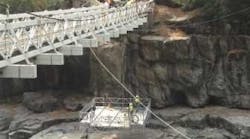About 75 years ago, a method of paving asphalt roads as preventive maintenance started in Germany using a cold process mixture that was fluid enough to be spread with brooms, squeegees and spreader boxes. That first wet-mix process was used to pave the Berlin-Staaken Airport in 1936.
The excellent results created in Germany caught the eyes of federal, state and local governments in the United States, which wanted to save money while repairing the roads as rapidly as possible.
In 1938, the United States began experimenting with different wet mixes that, by the late 1940s, created road maintenance equipment that used what was called slurry seal. Extensive interest in the seal began during the 1960s when emulsifiers were introduced into the mixture. Slurry seal led to micro surfacing, a process also first introduced in Germany and used in thicker applications, such as in ruts, that didn’t destroy road striping on the autobahn.
The new material was composed of an integral latex modified asphalt emulsion; selected crushed aggregates; and a combination of emulsifiers, adhesion agents, and fillers that remained stable during application.
Popular repair method
The process became more popular in the east and west coasts of the United States because of the fast and easy application for the number of roads that had to be maintained. The Midwest began using micro surfacing about 10 years ago. Cities and counties like micro surfacing so much that many have abandoned other forms of asphalt repair.
The micro-surfacing repair of 30 miles of a rural road in North Dakota was completed in two weeks in July. Steve Wolf, project engineer at the North Dakota Department of Transportation, said the contractor, Mayo Construction, didn’t have to mill the road as in previous repair projects. “The repair started on Highway 36 at the junction of Highway 3 going east for about 30 miles to the town of Woodworth,” said Wolf.
“There was an aggregate pit on the project limits that produced aggregate on site, placed them in a pile, and was mixed in a machine with other components to produce the slurry.” Wolf said. “They put down a slurry on the road surface with squeegees behind the machine. We didn’t have to close the road; we had a flagging operation with traffic going around the road. It cured in a couple of hours and we opened the road to traffic.”
Micro surfacing process
Greg Mayo, co-owner and secretary-treasurer at Mayo Construction in Cavalier, ND, said the Highway 36 pavement had aged over the years with local farm-to-market traffic. “There is an aggregate pit in this area, and we brought in a portable crusher to custom crush the aggregate. We loaded it into our trucks using a wheel loader and then brought it to our specialized micro-paver. The aggregate was mixed with emulsion, water and Portland cement in a pug mill and is dropped behind the paver. Then, the screed attached to the paver strikes off the mixture to smooth the road. The truck fleet feeds the micro-paver steadily all day as it’s a continuous process,” said Mayo.
The process takes ruts and bumps out of the road. Mayo explained that the specialized paver mixes type II or type III aggregate, which passes 3⁄8-inch in size, with water, type II cement and polymer-modified emulsion used in liquid asphalt. The result is a slurry that comes out from the bottom of the machine and a screed, attached behind the machine, strikes off and smoothes the slurry.
“Within 20 to 30 minutes, the slurry hardens and the road is set,” Mayo said. “The length of this job is 30 miles, which took about two weeks for us to complete. A typical day is about seven or eight lane miles. Usually, we go down one lane for about seven miles and back up on the other side to complete both sides of the road.”
More prevalent use
Mayo Construction bought a Bergkamp M1 paver, which is self-propelled, full sized and offers continuous slurry while the machine is working. “With asphalt paving, we put the aggregate through a drum dryer and heat it,” Mayo said. “The moisture is removed as it is heated in a rotary kiln, then we inject liquid asphalt into the mix. The mix is then hauled and placed with a paver and is compacted with several different types of rollers.
“Micro surfacing doesn’t use compactors, and it’s a cold process. The slurry is released on the road surface covering about 5⁄8 of an inch or less. It’s a very thin product and that’s why it’s called micro.”
Mayo Construction used micro surfacing for dozens of county and city road projects in North Dakota and is the only asphalt contractor in North Dakota to use this process. “After we’ve done one project with governments, officials just abandon the seal coat operation and go with micro surfacing,” explained Mayo. “State and county engineers like this process because it restores the surface and takes out the bumps and ruts. They’re learning that it’s a better process in lieu of a seal coat. The process costs more than a regular seal coat and lasts about the same time but it looks like a new paved surface.”
Asphalt roads are sealed on a seven-year cycle and micro surfacing is a newer technique. “Engineers seem to like this method better so we’ve had tremendous response,” said Mayo.
Short paving season
“In North Dakota, typically, we don’t start micro surfacing until mid-May; we have to wait until the load limits come off of roads, and we’ll work until mid-September because that’s when we start dealing with cold temperatures. You want temperatures of 50 degrees and rising,” Mayo stated.
Wolf, from the North Dakota DOT, said this process doesn’t create flying rocks that the chip seal process creates and the time required to maintain the 30 miles was much shorter. Mayo agreed engineers like this process for the same reasons.
As the only asphalt paving contractor using micro surfacing, Mayo is optimistic about getting more maintenance projects not only in North Dakota but also in surrounding areas.




